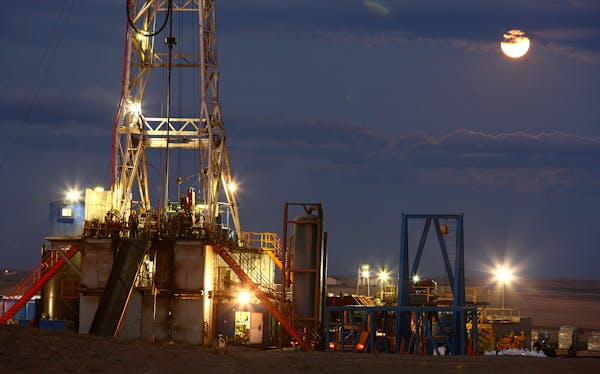Oil producers and marketers have signed long-term commitments to ship Bakken crude oil on a proposed 600-mile pipeline across North Dakota and Minnesota, boosting the project's chances of getting built.
Shippers committed to sending 155,000 barrels of oil per day down the line, a significant share of its capacity, according to a regulatory filing by Enbridge Energy, which wants to build the $2.7 billion project by early 2016.
Such commitments — to specific monthly oil shipments for five to 15 years — are crucial to financing pipelines. Companies must ship oil — or pay Enbridge anyway. Two other North Dakota pipeline projects have fallen apart because shippers wouldn't commit.
"It makes the project economically, financially viable," Enbridge spokeswoman Katie Haarsager said in an interview Friday. "It is what makes us move forward with the project with confidence."
North Dakota officials hope that pipelines eventually will replace many of the roughly 10 daily oil trains that haul away much of the state's oil bounty. About eight oil trains, each with about 110 tank cars, pass through Minnesota daily, according to MnDOT.
"It is one thing to put together a project, but until you get the shipper commitments, there's a level of uncertainty, and now that's been firmed up," said Justin Kringstad, director of the North Dakota Pipeline Authority, a state agency that assists in pipeline development.
In November, the Sandpiper project got another boost when Marathon Petroleum Corp. agreed to help finance the project in return for a 27 percent stake.
Enbridge on Wednesday filed details of the shipper sign-up process, known as an "open season," with the Federal Energy Regulatory Commission, which sets rates on pipelines. Shippers signed up for two-thirds of the proposed line's capacity between Beaver Lodge, N.D., and Clearbrook, Minn. The remaining capacity was left for shippers who don't want, or can't afford, to make long-term commitments, the filing said.
Enbridge, based in Calgary, said it expects more demand for the Sandpiper line as other pipeline projects are finished to carry more oil further east, including to refineries in eastern Canada. The line also will boost capacity between Clearbrook and Superior, Wis., where Enbridge has oil terminals. The project is under review by utility regulators in Minnesota and North Dakota.
The line would follow the path of Enbridge's existing oil pipeline from North Dakota to Clearbrook. That line operates at a reduced capacity of 170,000 barrels per day because testing is underway, the filing said. In mid-2013, that line operated at even lower capacity as shippers opted for other ways to market. But Enbridge said demand is up again, and it will outstrip capacity even after the line returns to full pressure.
When both lines are up and running, they would have the capacity to ship about 38 percent of North Dakota's projected 2016 output. Enbridge says it already has invested more than $1 billion to expand pipeline and rail capacity in the state.
North Dakota's reliance on 100-car-long trains to ship most of its oil has become a concern of Minnesota fire fighters who say they lack special equipment to fight a major fire. Oil train accidents, including one on Dec. 30 that caused the partial evacuation of Casselton, N.D., have brought calls by legislators to better prepare for possible disasters.
Sandy Fielden, an analyst for RBN Energy, a Houston-based consulting firm, said rail likely will remain a preferred option for shipping North Dakota crude to the West and East coasts, where refineries are not served by pipelines. The crude-by-rail business model relies on North Dakota oil trading at a lower price to coastal crude in order to cover the higher cost of shipping.
"There is room for Sandpiper," Fielden said. "But there is still going to be a need for rail."
David Shaffer • 612-673-7090 Twitter: @ShafferStrib
Owner of exploding Michigan building arrested at airport while trying to leave US, authorities say
Surging auto insurance rates squeeze drivers, fuel inflation

